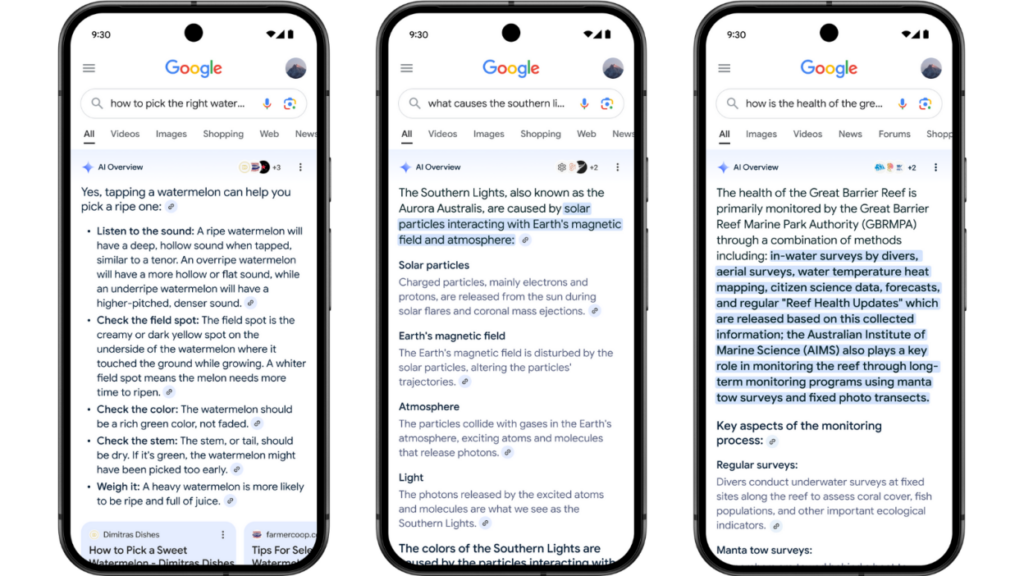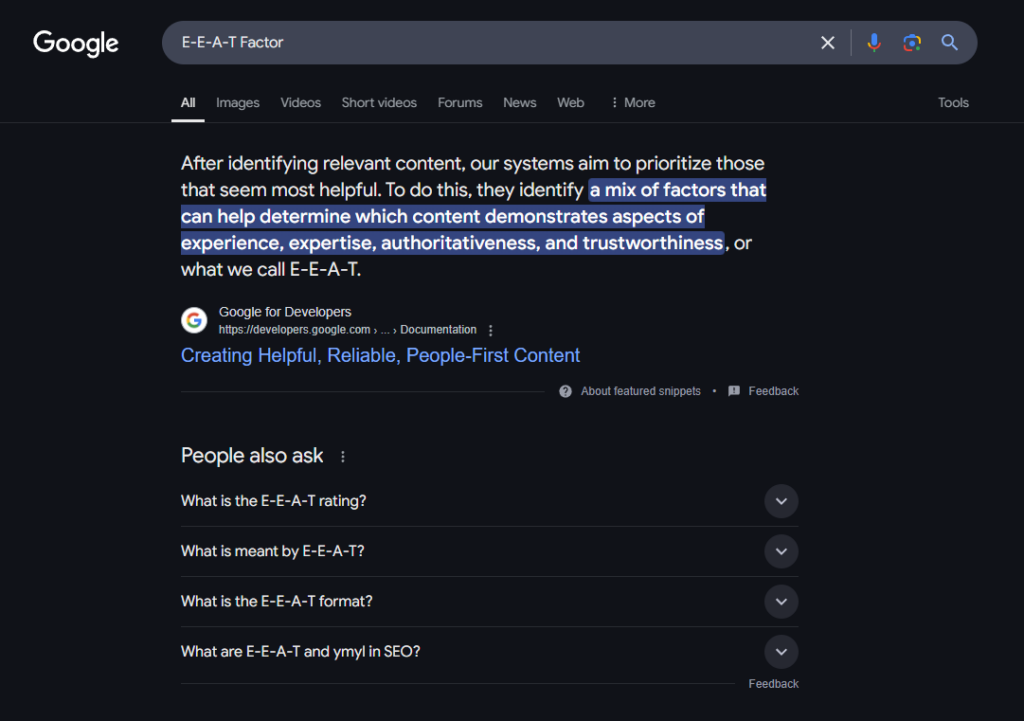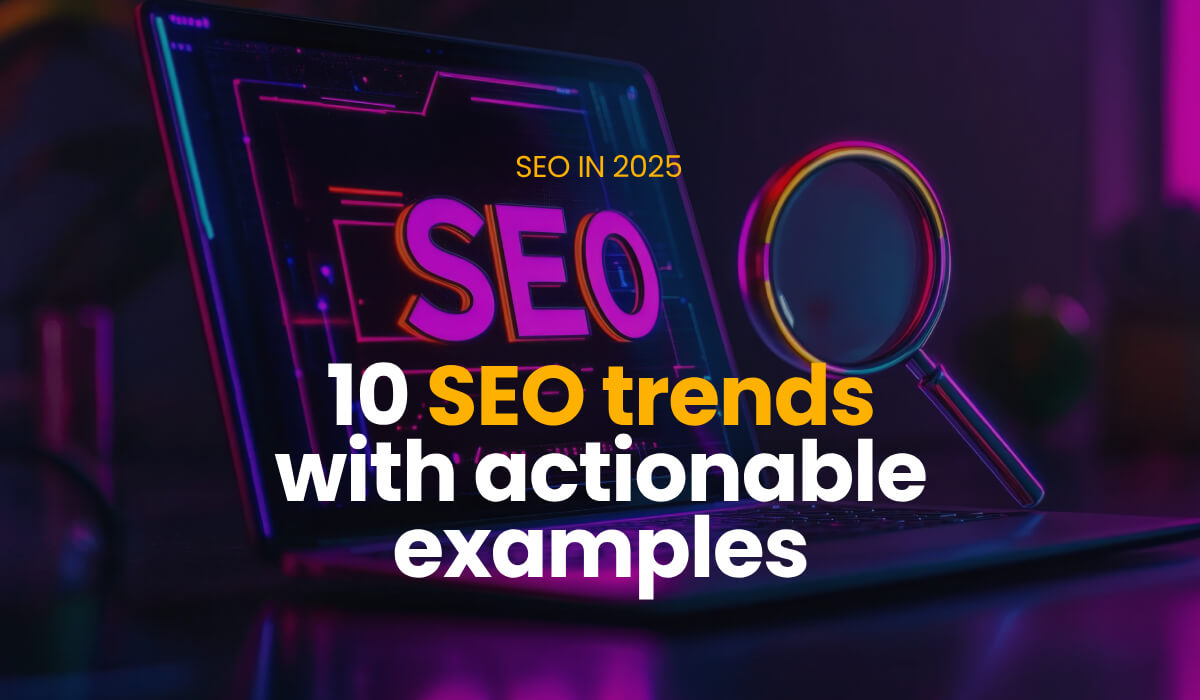Not so long ago, SEO was all about cramming keywords into your content and building a network of backlinks. Though those days are gone, there are still those who stick to these bad practices. With AI, shifting user-behavior, and the always-and-eternally-changing search engine algorithms at the forefront, SEO in 2025 is a whole new ballgame.
Buckle up, because we’re going to dive into the 10 biggest SEO trends that seem to be shaping the future of digital marketing:
- AI-Generated Search Results,
- AI-Powered Answer Engines (Chatbots),
- Community-Based Search Results,
- First-Hand Experience,
- Zero-Click Searches,
- Video and Visual Searches,
- Brand Authority and Entity-Based SEO,
- Local SEO and Voice Search,
- AI-Generated Content and Human Oversight, and
- Website Speed and Performance.
#1 AI-Generated Search Results: the Rise of the Machines
Google’s AI Overviews and Bing’s AI-powered results are changing the game by providing instant answers directly on the search results page (SERP).
Since these AI overviews are generated from multiple sources, this will result with no direct visits to your website, especially if users are able to get the whole answer from the overviews alone.

Though AI overview services are not yet available in all countries (Mashable), according to Google, this is what’s really important to know:
Google’s systems automatically determine which links appear. There is nothing special for creators to do to be considered other than to follow our regular guidance for appearing in search.
To stay ahead and create a chance to get featured in the AI overview, you need to create concise, structured content that is AI-friendly, such as:
- FAQs,
- bullet points (lists, just like this one),
- How-Tos,
- and other schema markup friendly data.
For example, if you’re writing an article about “Sustainability trends in 2025”, you can start your introduction like this:
“The biggest sustainability trends in 2025 are sustainable materials, solar power and reuse. Studies have shown that these trends have the biggest impact on reversing the climate changes”. In addition, include the source for these claims or citation.
This approach increases your chances of being cited in AI overviews.
#2 AI-Powered Answer Engines (Chatbots): Your New Best Friend
AI chatbots like ChatGPT, OpenAI, Gemini, and DeepSeek, are becoming the go-to source for information.

AI chatbots often cite articles in their responses, thus driving traffic to those websites.
In the image example above, we asked ChatGPT “Why is the OceanWP theme best theme for WordPress”. In its reply, ChatGPT cited 2 main sources (one of those sources being an awesome review left by one of the OceanWP theme users, so we’re going to use this opportunity to thank all of you for your continuous support). In the sidebar area, ChatGPT offered even more (re)sources.
The key to leveraging this SEO trend is to produce data-rich, authoritative content that AI models simply can’t resist referencing, such as:
- original research,
- statistics,
- and expert interviews,
- and other content that will help you increase credibility.
For example, if you’re writing an article titled “Coffee makes the world a happier and safer place”, you can start your introduction like this:
“Studies have shown that allowing people to finish their first coffee without interruption increases happiness by 200%”. Of course, include the source for these claims or citation.
This approach increases the likelihood of AI chatbots referencing your content.
#3 Community-Based Search Results: the Power of the People
User-generated content (UGC), from platforms such as Reddit, Quora or LinkedIn, is gaining prominence in Google’s search results (Search Engine Journal).

To tap into this SEO trend, you can get involved in online discussions and foster a sense of community:
- engage in discussions on Reddit or Quora,
- encourage comments and discussions on your own website (through forums, or articles),
- encourage comments and discussions through your related social media (Facebook pages and groups, X (Twitter), and more).
For example, instead of just writing a blog article on the topic “How to beat the rising costs of living”, you can engage on Reddit’s r/financialindependence/ with:
“As a family of 4, this is how we cut food expenses for $500 a month. AMA (Ask Me Anything)”.
This approach builds credibility and can lead to increased site traffic.
#4 First-Hand Experience: the E-E-A-T Factor
Google’s E-E-A-T (Experience, Expertise, Authoritativeness, Trustworthiness) now prioritizes first-hand experience.
Though E-E-A-T is not truly a ranking factor, but rather a framework that Google’s human reviewers use to asses content quality (Semrush), you can still make use of this SEO trend to your advantage by sharing personal experience in your content:
- include case / use studies,
- share client testimonials,
- share original research / experiments.
For example, instead of writing “SEO is important for website ranking”, try this:
“In 2025, we started following 3 of the biggest SEO trends shared by OceanWP in this article, and this has increased our website traffic by 200% in only 5 months”.
Real-world data can significantly boost your credibility.
#5 Zero-Click Searches: the Need for Immediate Answers
In 2024, around 65% of global Google searches didn’t result in a click, while on mobile that number was even higher with 75% (WordStream).
With that stat in mind, optimizing for featured snippets and People Also Ask (PAA) questions is crucial to get your content noticed even without a click-through.

In the image above we have the example of a featured snippet, followed by the PAA section.
To optimize your website content for featured snippets and PAA, you can:
- use short and direct answers,
- use structured data,
- try giving answers to PAA questions inside your content.
For example, if you’re writing an article on “Best dog toys”, perform a Google search on your topic, and check the PAA questions, then try including answers to those questions in your article, such as:
- What is the best toy to give a dog?
- What toys do all dogs love?
- What is the safest and friendliest dog toy?
This approach will increase your chance for Google displaying your content in one of the PAA boxes.
#6 Video and Visual Search: a Feast for the Eyes
With Google Lens and TikTok leading the charge (Elixirr Digital), visual content is king – they are transforming how people find information through images and videos.

Whether you’re into images, videos or both, you can join this SEO trend by:
- including appropriate alt (descriptive) text with your content images,
- upload images and videos with descriptive file names,
- add catchy captions to your TikTok videos.
For example, if you’re writing an article titled “Best stretches for back pain”, you can create a 60-sec TikTok video with the caption “Eliminate back pain with these 3 stretches”.
Since Google is now also indexing TikTok videos, if you’re into this platform, it can help you boost visibility by increasing your reach.
#7 Brand Authority and Entity-Based SEO: Building Your Reputation
Google favors well-established brands and entities (iMark Infotech), over individual keyword ranking.
Building brand authority doesn’t happen over night, but you can achieve this goal:
- strengthen your brand identity across multiple platforms (LinkedIn, Medium, YouTube),
- get brand mentions in major publications and directories,
- create a Wikipedia page for your brand,
- list your business on Google Maps or Crunchbase.
#8 Local SEO and Voice Search: Hey, Find Me a Pet-Friendly Coffee Shop
Voice search is on the rise (Invoca), and it’s all about conversational, localized queries.

Optimizing for voice search SEO trend is your chance to optimize for long-tail, conversational keywords, and align with how people talk to voice assistants like Siri, Alexa, Bixby, or Gemini.
However, when it comes to local SEO and voice search, the only valuable recommendations we found is to keep your Google Business Profile (aka Google My Business) up to date.
For example, instead of describing your business as “The best coffee shop in Manhattan”, think about how you or anyone you know would do a voice search on a coffee shop, and apply that to describe your business as: “The best pet-friendly coffee shop with a smoking area is located in Manhattan”.
#9 AI-Generated Content: the Human Touch
AI-written content is becoming more and more common (sadly), but Google still values human oversight (luckily).
Use AI tools for article or blog post drafting or outlining, but add expert insight, case studies, citations, and real-world examples to make the content really shine.

By doing so, you will also ensure you’re not spreading false information, which does happen when AI misrepresents or rewrites the info pulled from various online sources.
For more information, check out Google Search’s guidance about AI-generated content.
#10 Website Speed and Core Web Vitals: the Need for Speed
Google dislikes slow-loading websites, as much as the next person (90 Degree Design). At the same time, mobile-friendliness is a plus when it comes to ranking factors (Blue Interactive Agency).
However, here at OceanWP we always like to emphasize that the real and actual website speed (the way you and your users perceive web page loading), always beats pumped-up Core Web Vitals scores because even Google tells you each time those are estimated values.
On the other hand, real web speed – the one that actually matters – info is gathered over time, based on your users’ experience and interaction.

So, when it comes website speed as an always-trending SEO element, we’ll share the same advice we always do – follow the best website building practices:
- quality hosting: use quality hosting services – your website speed starts with the quality of the remote PC your site is hosted on;
- well-coded themes and plugins: use well coded WordPress themes and plugins (like OceanWP 😉 );
- optimized images: optimize images before you upload them to your website;
- know your tools: don’t add unnecessary CSS and PHP codes, or additional plugins, if your theme and existing plugins are already capable of achieving the exact same results;
- website caching: use caching plugins (don’t use 2 or more plugins that are doing exactly the same, your website will run slower);
- SSL certificate: ensure to apply an SSL certificate, such as Let’s Encrypt, to deliver your content via a secure connection (https:// instead of http://);
- use CDN: connect your website to a Content Delivery Network, like Cloudflare.
- optimized database: optimize your database from time to time;
- reduce animation amount: dull down on animations and auto-playing videos, especially in the hero section and mobile version of your website;
- avoid popups on website load: town it down on popups – nobody wants 15 popups before your content even loads;
- be mindful: follow accessibility guidelines when it comes to the text size, contrast, H tags hierarchy, descriptive image (alt) text, link descriptions, etc;
- be smart: use Site Booster to optimize and secure your WordPress website.
Final Thoughts
Optimizing your website for SEO is not an easy task. In fact, it’s something to always have in mind from the moment you start your website, as it will dictate almost every step you make moving forward.
The sooner you realize that all roads lead to SEO, the better.
As for this year’s trends, SEO in 2025 is an exciting blend of AI, community, and user experience. By embracing these trends and focusing on high-quality, authoritative content, you can navigate the ever-changing SEO landscape with confidence and achieve lasting success.
Which trend are you focusing on this year?
